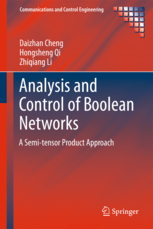内容简介:
布尔网络已成为描述和模拟细胞网络(其元素只有开关行为)的强大工具。本书提供了系统地分析和控制布尔网络的全新方法,基本工具是称为矩阵半张量积的这一新的矩阵乘法。使用矩阵半张量积可将逻辑函数表示成传统的离散时间线性系统,从而可以通过一组公式轻松揭示布尔网络拓扑结构的一些基本特性,如不动点、极限环、暂态期和吸引域等。这一理论框架使得动态控制系统的状态空间方法可应用于布尔网络的控制。布尔控制网络的双线性系统表示使得研究其能控、能观、镇定、干扰解耦、辨识、最优控制等基本控制问题成为可能。
本书自成体系,读者只需线性代数和线性控制系统的基本知识。本书开始于对命题逻辑和矩阵半张量积的简要介绍。然后用布尔(控制)网络的(双)线性表示研究其干扰解耦和分解等问题。最后,考虑到多值逻辑能够更准确地描述实际的网络,本书也对其做了介绍并引入随机布尔网络等。附录是相关的数值计算,相关的MATLAB®工具箱可从http://lsc.amss.ac.cn/~dcheng/下载。
本书可为从事系统生物学、控制、系统科学和物理相关领域的研究人员提供基本参考,也可成为研究生课程的教材。计算机科学家和逻辑学家或许也能从本书中找到感兴趣的内容。
英文目录:
1 Propositional Logic
1.1 Statements
1.2 Implication and Equivalence
1.3 Adequate Sets of Connectives
1.4 Normal Form
1.5 Multi-valued Logic
References
2 Semi-tensor Product of Matrices
2.1 Multiple-Dimensional Data
2.2 Semi-tensor Product of Matrices
2.3 Swap Matrix
2.4 Properties of the Semi-tensor Product
2.5 General Semi-tensor Product
References
3 Matrix Expression of Logic
3.1 Structure Matrix of a Logical Operator
3.2 Structure Matrix for k-valued Logic
3.3 Logical Matrices
References
4 Logical Equations
4.1 Solution of a Logical Equation
4.2 Equivalent Algebraic Equations
4.3 Logical Inference
4.4 Substitution
4.5 k-valued Logical Equations
4.6 Failure Location: An Application
4.6.1 Matrix Expression of Route Logic
4.6.2 Failure Location
4.6.3 Cascading Inference
References
5 Topological Structure of a Boolean Network
5.1 Introduction to Boolean Networks
5.2 Dynamics of Boolean Networks
5.3 Fixed Points and Cycles
5.4 Some Classical Examples
5.5 Serial Boolean Networks
5.6 Higher Order Boolean Networks
5.6.1 First Algebraic Form of Higher Order Boolean Networks
5.6.2 Second Algebraic Form of Higher Order Boolean Networks
References
6 Input-State Approach to Boolean Control Networks
6.1 Boolean Control Networks
6.2 Semi-tensor Product Vector Space vs. Semi-tensor Product Space
6.3 Cycles in Input-State Space
6.4 Cascaded Boolean Networks
6.5 Two Illustrative Examples
References
7 Model Construction via Observed Data
7.1 Reconstructing Networks
7.2 Model Construction for General Networks
7.3 Construction with Known Network Graph
7.4 Least In-degree Model
7.5 Construction of Uniform Boolean Network
7.6 Modeling via Data with Errors
References
8 State Space and Subspaces
8.1 State Spaces of Boolean Networks
8.2 Coordinate Transformation
8.3 Regular Subspaces
8.4 Invariant Subspaces
8.5 Indistinct Rolling Gear Structure
References
9 Controllability and Observability of Boolean Control Networks
9.1 Control via Input Boolean Network
9.2 Subnetworks
9.3 Controllability via Free Boolean Sequence
9.4 Observability
References
10 Realization of Boolean Control Networks
10.1 What Is a Realization?
10.2 Controllable Normal Form
10.3 Observable Normal Form
10.4 Kalman Decomposition
10.5 Realization
References
11 Stability and Stabilization
11.1 Boolean Matrices
11.2 Global Stability
11.3 Stabilization of Boolean Control Networks
References
12 Disturbance Decoupling
12.1 Problem Formulation
12.2 Y -friendly Subspace
12.3 Control Design
12.4 Canalizing Boolean Mapping
12.5 Solving DDPs via Constant Controls
References
13 Feedback Decomposition of Boolean Control Networks
13.1 Decomposition of Control Systems
13.2 The Cascading State-space Decomposition Problem
13.3 Comparable Regular Subspaces
13.4 The Parallel State-space Decomposition Problem
13.5 Input–Output Decomposition
References
14 k-valued Networks
14.1 A Review of k-valued Logic
14.2 Dynamics of k-valued Networks
14.3 State Space and Coordinate Transformations
14.4 Cycles and Transient Period
14.5 Network Reconstruction
14.6 k-valued Control Networks
14.7 Mix-valued Logic
References
15 Optimal Control
15.1 Input-State Transfer Graphs
15.2 Topological Structure of Logical Control Networks
15.3 Optimal Control of Logical Control Networks
15.4 Optimal Control of Higher-Order Logical Control Networks
References
16 Input-State Incidence Matrices
16.1 The Input-State Incidence Matrix
16.2 Controllability
16.3 Trajectory Tracking and Control Design
16.4 Observability
16.5 Fixed Points and Cycles
16.6 Mix-valued Logical Systems
References
17 Identification of Boolean Control Networks
17.1 What Is Identification?
17.2 Identification via Input-State Data
17.3 Identification via Input–Output Data
17.4 Numerical Solutions
17.4.1 General Algorithm
17.4.2 Numerical Solution Based on Network Graph
17.4.3 Identification of Higher-Order Systems
17.5 Approximate Identification
References
18 Applications to Game Theory
18.1 Strategies with Finite Memory
18.2 Cycle Strategy
18.3 Compounded Games
18.4 Sub-Nash Solution for Zero-Memory Strategies
18.5 Nash Equilibrium for μ-Memory Strategies
18.6 Common Nash (Sub-Nash) Solutions for μ-Memory Strategies
References
19 Random Boolean Networks
19.1 Markov Chains
19.2 Vector Form of Random Boolean Variables
19.3 Matrix Expression of a Random Boolean Network
19.4 Some Topological Properties
References
Appendix A Numerical Algorithms
A.1 Computation of Logical Matrices
A.2 Basic Functions
A.3 Some Examples
Appendix B Proofs of Some Theorems Concerning the Semi-tensor Product

